In this ultimate guide to outdoor furniture materials, we will delve into the world of choices available, to help you select the perfect pieces for your outdoor oasis. Choosing the right materials is crucial in ensuring the longevity, comfort, and aesthetic appeal of your outdoor furniture. When it comes to outdoor furniture, the materials you choose play a vital role in determining its durability and ability to withstand the elements. we've got you covered in this Ultimate Guide to Outdoor Furniture Materials.
Understanding the characteristics and benefits of different outdoor furniture materials is essential for selecting the right one that suits your style, climate, and maintenance preferences. From weather-resistant and stunning teak wood to the durable and versatile synthetic polyethylene rope, each material has its unique charm and advantages. With this ultimate guide to outdoor furniture materials, you'll gain insights into the various types of wood, rope, wicker, and rattan materials, and their suitability for outdoor use.
Outdoor Furniture Materials
There are various types of materials used for outdoor furniture, each with its own advantages and characteristics. Here are some commonly used outdoor furniture materials:

- Wood
- Wicker/Rattan
- Rope
- Metal
- Plastic/Resin
- Concrete
1. Wood
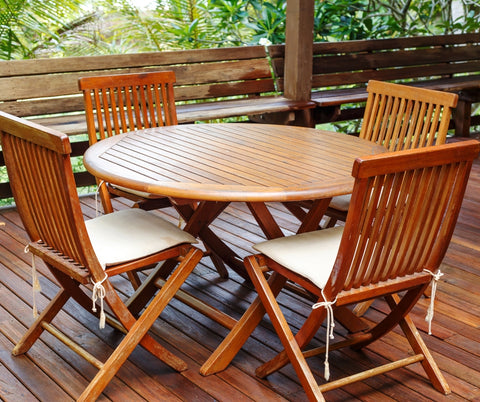
Wood is a classic and popular choice for outdoor furniture. Common types of wood used include teak, cedar, redwood, and pine. However, it requires regular maintenance, such as sealing or staining, to protect it from the elements. There are several types of wood commonly used for outdoor furniture, each with its own unique characteristics and benefits.
Teak:
Teak is one of the most sought-after wood materials for outdoor furniture. It is highly valued for its natural resistance to water, rot, and insects. Teak's dense grain and high oil content make it exceptionally durable and weather-resistant, allowing it to withstand harsh outdoor conditions.
Cedar:
Cedar is another popular choice for outdoor furniture. Known for its natural resistance to decay and insect damage. While cedar can be left untreated, applying a protective finish will help prolong its lifespan and maintain its color.
Eucalyptus:
Eucalyptus is a versatile wood that is commonly used in outdoor furniture manufacturing. Furniture with Eucalyptus often features a warm reddish-brown hue and a straight grain pattern. Regular maintenance, such as applying a protective sealant, can help preserve its appearance and prolong its lifespan.
Acacia:
Acacia is another hardwood frequently used in outdoor furniture construction. It offers similar characteristics to teak, such as excellent weather resistance and durability. Acacia's natural oils and tight grain contribute to its resistance against water damage and rot.
When selecting outdoor furniture made of wood, it is important to consider the specific wood type and its suitability for your climate and intended use. Whether it's the luxurious appeal of teak, the aromatic beauty of cedar, the strength of eucalyptus, or the durability of acacia, wood materials offer a natural and timeless choice for outdoor furniture enthusiasts.
2. Wicker/Rattan
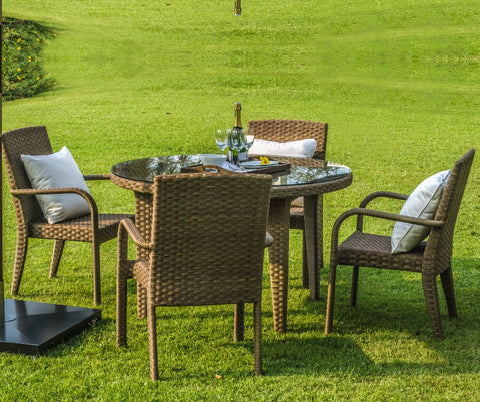
Outdoor furniture made from wicker or rattan materials exudes a timeless charm and brings a touch of natural elegance to outdoor spaces. It provides a natural and rustic look. While natural wicker is not suitable for prolonged exposure to rain and sunlight, synthetic wicker made from resin or polyethylene is more durable and weather-resistant. There are various types of wicker and rattan materials used in outdoor furniture, each with its own unique qualities and benefits.
Natural rattan:
Natural rattan is derived from the stems of a vine-like palm plant. It is lightweight, flexible, and has a natural warm tone, making it a popular choice for outdoor furniture. Rattan is known for its strength and durability, allowing it to withstand outdoor conditions with proper care.
Synthetic rattan:
Synthetic rattan, often referred to as resin wicker, has become increasingly popular for outdoor furniture. It is made from polyethylene or PVC. Synthetic rattan is designed to mimic the look and feel of natural rattan. Also, it is resistant to fading, cracking, and peeling, making it a low-maintenance option for outdoor use. Synthetic rattan furniture is available in various colors and weaves, providing flexibility in design and customization.
Wicker:
Wicker refers to the weaving technique rather than the material itself. The materials are woven together to create a sturdy and intricate pattern. Wicker furniture is typically made from natural materials such as rattan, bamboo, or reed.
When selecting outdoor furniture made from wicker or rattan, it is important to consider the quality of the materials and construction. Look for tightly woven patterns and sturdy frames to ensure longevity. Additionally, consider the climate and intended use of the furniture, as some materials may require more maintenance in certain conditions. Outdoor furniture made from wicker or rattan materials adds a touch of sophistication and natural beauty to outdoor spaces.
3. Rope
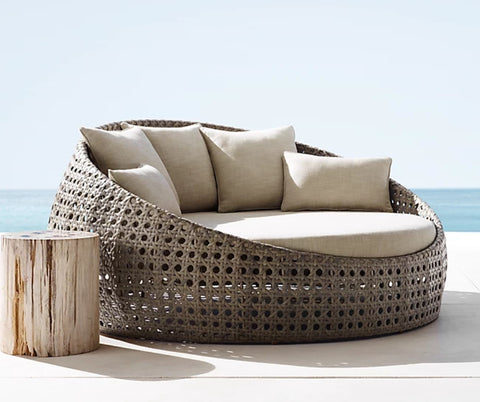
Outdoor furniture rope materials have gained popularity in recent years as a stylish and durable alternative to traditional upholstery. They offer a unique and contemporary aesthetic while providing comfort and functionality. There are several types of rope materials commonly used in outdoor furniture;
PE Rope:
One popular rope material used in outdoor furniture is synthetic polyethylene (PE) rope. PE rope is highly durable and resistant to UV rays, moisture, and harsh weather conditions, making it ideal for outdoor use. PE rope is available in various thicknesses, colors, and weaves, allowing for creative designs and customization.
Polyester Rope:
Another commonly used rope material is polyester rope. Polyester is known for its strength and durability, as well as its resistance to fading and mildew. It has a soft and comfortable feel, making it suitable for seating areas. Also, Polyester rope is available in a wide range of colors and can be woven in different patterns, providing versatility in design options.
Hemp or Jute Rope:
Natural materials like hemp or jute rope can also be used in outdoor furniture. These ropes offer a rustic and organic look, adding a touch of natural beauty to outdoor spaces. Natural ropes may require more maintenance than synthetic options, they can be treated with water-resistant coatings to improve their durability and lifespan.
When selecting outdoor furniture with rope materials, it is important to consider the quality and construction of the ropes. Look for tightly woven ropes with strong tensile strength to ensure longevity. Whether it's the resilience and color options of synthetic PE rope, the strength and fade resistance of polyester rope, or the natural and rustic appeal of hemp or jute rope, these materials offer a versatile and stylish choice for outdoor furniture that can withstand the elements and enhance the overall aesthetic of any outdoor setting.
4. Metal
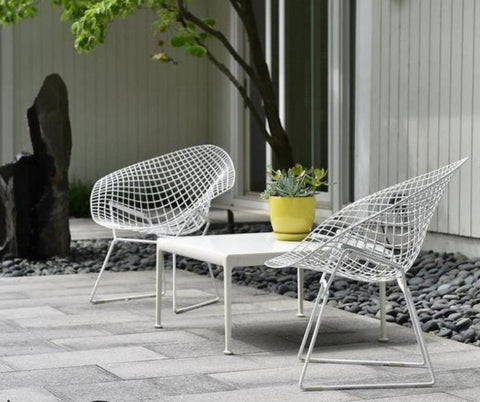
Outdoor metal furniture is known for its strength and durability. Common metals used include aluminum, wrought iron, and steel. Aluminum furniture is lightweight, resistant to rust, and easy to maintain. Wrought iron is heavier and more ornate, often featuring intricate designs, but it requires regular maintenance to prevent rust. Steel is sturdy but can be prone to rust unless properly treated with a protective finish.
5. Plastic/Resin
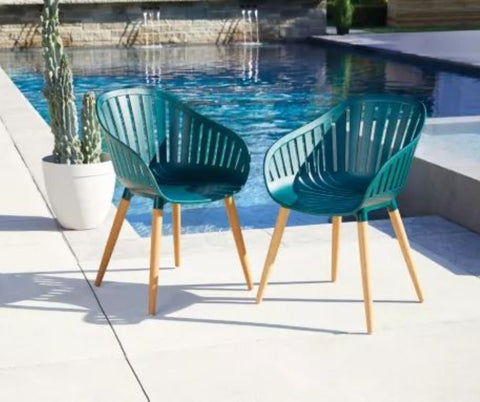
Plastic or resin outdoor furniture is lightweight, affordable, and low-maintenance. It is often made from materials like high-density polyethylene (HDPE) or recycled plastic. Plastic furniture is resistant to moisture, fading, and insects, making it suitable for various weather conditions. It comes in a range of colors and styles.
6. Concrete
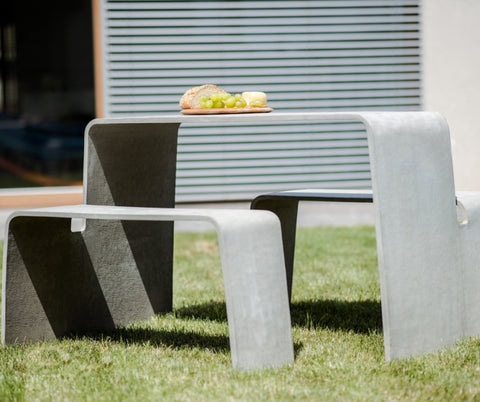
Concrete furniture is robust and highly durable. It can be molded into different shapes and sizes to create unique designs. Concrete furniture is heavy and less portable but can withstand harsh weather conditions. It often requires sealing to protect it from stains and moisture.
What type of outdoor furniture is the most durable?
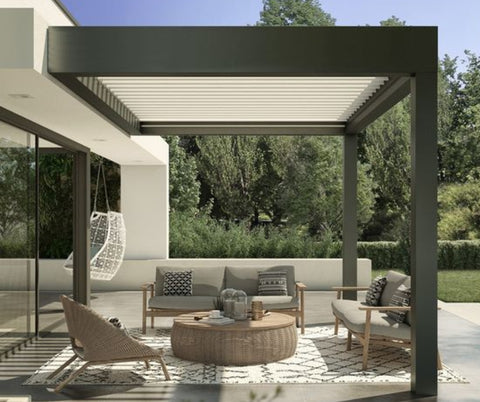
- Aluminum: Powder-coated versions will do well in all environments, but may be a bit lightweight for extremely windy conditions (cast or wrought aluminum better)
- Teak & Other Hardwoods: If properly sealed and periodically treated, these sturdy woods will last a long time and develop a nice patina but some hardwoods may warp or crack if not protected
- Resin Wicker: HDPE wicker is extremely strong and will resist damage from moisture, high temperature and UV rays, although it may blow away if not weighted down in high wind locations
- Stainless Steel: Its high-density, weight and strength make this metal great for outdoor tables in most climates and it resists corrosion the higher the chromium content or if powder-coated, although it does get hot in the sun
- Wrought Iron: This extremely heavy material can last a century if properly cared for, but it does require a lot of TLC to clean and protect from rusting
Finally,
Are you ready to transform your outdoor space into a haven of relaxation and style? Look no further! Our ultimate guide to outdoor furniture materials will assist you in making an informed decision. When choosing outdoor furniture, consider the climate in your area, the desired aesthetics, durability requirements, and maintenance preferences to select the most suitable material for your needs. Shop from our collection of outdoor furniture to give your patio a new look today!










